Validity of a Wheelchair Rugby Field Test to Simulate Physiological and Thermoregulatory Match Outcomes
Abstract
:1. Introduction
2. Materials and Methods
2.1. Participants
2.2. Study Design
2.3. Game-Assessment
2.4. Field Test Assessment
2.5. Statistics
3. Results
4. Discussion
4.1. Performance Parameters
4.2. Physiological Parameters
4.3. Thermal and Thermoregulatory Responses
4.4. Limitations
4.5. Practical Applications
5. Conclusions
Author Contributions
Funding
Institutional Review Board Statement
Informed Consent Statement
Data Availability Statement
Acknowledgments
Conflicts of Interest
References
- Currell, K.; Jeukendrup, A.E. Validity, Reliability and Sensitivity of Measures of Sporting Performance. Sports Med. 2008, 38, 297–316. [Google Scholar] [CrossRef] [PubMed]
- Perret, C.; Abel, T. Physiology. In Training and Coaching the Paralympic Athlete; John Wiley & Sons: Hoboken, NJ, USA, 2016; pp. 53–74. [Google Scholar]
- Kimberlin, C.L.; Winterstein, A.G. Validity and reliability of measurement instruments used in research. Am. J. Health Syst. Pharm. 2008, 65, 2276–2284. [Google Scholar] [CrossRef]
- Rhodes, J.; Mason, B.S.; Perrat, B.; Smith, M.J.; Malone, L.A.; Goosey-Tolfrey, V.L. Activity profiles of elite wheelchair rugby players during competition. Int. J. Sports Physiol. Perform. 2015, 10, 318–324. [Google Scholar] [CrossRef] [PubMed]
- Goosey-Tolfrey, V.L.; Leicht, C.A. Field-Based Physiological Testing of Wheelchair Athletes. Sports Med. 2013, 43, 77–91. [Google Scholar] [CrossRef] [PubMed]
- Gee, C.M.; Lacroix, M.A.; West, C.R. A 20 × 20 m repeated sprint field test replicates the demands of wheelchair rugby. J. Sports Sci. Med. 2018, 21, 753–757. [Google Scholar] [CrossRef]
- Goosey-Tolfrey, V.L.; Tolfrey, K. The multi-stage fitness test as a predictor of endurance fitness in wheelchair athletes. J. Sports Sci. 2008, 26, 511–517. [Google Scholar] [CrossRef] [PubMed]
- Vanderthommen, M.; Francaux, M.; Colinet, C.; Lehance, C.; Lhermerout, C.; Crielaard, J.M.; Theisen, D. A multistage field test of wheelchair users for evaluation of fitness and prediction of peak oxygen consumption. J. Rehabil. Res. Dev. 2002, 39, 685–692. [Google Scholar] [PubMed]
- Grossmann, F.; Flueck, J.L.; Perret, C.; Meeusen, R.; Roelands, B. The Thermoregulatory and Thermal Responses of Individuals With a Spinal Cord Injury During Exercise, Acclimation and by Using Cooling Strategies—A Systematic Review. Front. Physiol. 2021, 12, 636997. [Google Scholar] [CrossRef]
- Grossmann, F.; Perret, C.; Roelands, B.; Meeusen, R.; Flueck, J.L. Reliability of a submaximal field-test in wheelchair rugby. Int. J. Sports Med. 2022. online ahead of print. [Google Scholar] [CrossRef]
- World Medical Association. World Medical Association Declaration of Helsinki: Ethical principles for medical research involving human subjects. JAMA 2013, 310, 2191–2194. [Google Scholar] [CrossRef] [Green Version]
- ASIA and ISCoS International Standards Committee. The 2019 revision of the International Standards for Neurological Classification of Spinal Cord Injury (ISNCSCI)—What’s new? Spinal Cord 2019, 57, 815–817. [Google Scholar] [CrossRef]
- International Wheelchair Rugby Federation. Wheelchair Rugby Classifier Handbook; International Wheelchair Rugby Federation: Delta, BC, Canada, 2021. [Google Scholar]
- Rhodes, J.; Mason, B.; Perrat, B.; Smith, M.; Goosey-Tolfrey, V. The validity and reliability of a novel indoor player tracking system for use within wheelchair court sports. J. Sports Sci. 2014, 32, 1639–1647. [Google Scholar] [CrossRef]
- Borg, G.A. Psychophysical bases of perceived exertion. Med. Sci. Sports Exerc. 1982, 14, 377–381. [Google Scholar] [CrossRef]
- Arens, E.; Zhang, H.; Huizenga, C. Partial- and whole-body thermal sensation and comfort—Part I: Uniform environmental conditions. J. Therm. Biol. 2006, 31, 53–59. [Google Scholar] [CrossRef]
- Karros, D.J. Statistical Methodology: II. Reliability and Validity Assessment in Study Design, Part B. Acad. Emerg. Med. 1997, 4, 144–147. [Google Scholar] [CrossRef]
- Mukaka, M.M. Statistics corner: A guide to appropriate use of correlation coefficient in medical research. Malawi. Med. J. 2012, 24, 69–71. [Google Scholar]
- Bland, M.J.; Altman, D. Statistical Methods For Assessing Agreement Between Two Methods of Clinical Measurement. Lancet 1986, 327, 307–310. [Google Scholar] [CrossRef]
- Sarro, K.J.; Misuta, M.S.; Burkett, B.; Malone, L.A.; Barros, R.M.L. Tracking of wheelchair rugby players in the 2008 Demolition Derby final. J. Sports Sci. 2010, 28, 193–200. [Google Scholar] [CrossRef]
- Griggs, K.E.; Havenith, G.; Price, M.J.; Mason, B.S.; Goosey-Tolfrey, V.L. Thermoregulatory responses during competitive wheelchair rugby match play. Int. J. Sports Med. 2017, 38, 177–183. [Google Scholar] [CrossRef]
- Gavel, E.H.; Lacroix, M.A.; Goosey-Tolfrey, V.L.; Logan-Sprenger, H.M. Characterizing the Thermal Demands and Mobility Performance During International Wheelchair Rugby Competition. Front. Rehab. Sci. 2022, 3, 66. [Google Scholar] [CrossRef]
- Barfield, J.P.; Malone, L.A.; Arbo, C.; Jung, A.P. Exercise intensity during wheelchair rugby training. J. Sports Sci. 2010, 28, 389–398. [Google Scholar] [CrossRef]
- Theisen, D. Cardiovascular determinants of exercise capacity in the Paralympic athlete with spinal cord injury. Exp. Physiol. 2012, 97, 319–324. [Google Scholar] [CrossRef]
- Bhambhani, Y. Physiology of wheelchair racing in athletes with spinal cord injury. Sports Med. 2002, 32, 23–51. [Google Scholar] [CrossRef]
- Taylor, J.A. The Physiology of Exercise in Spinal Cord Injury; Springer: New Yourk, NY, USA, 2016. [Google Scholar]
- Baker, L.B. Sweating Rate and Sweat Sodium Concentration in Athletes: A Review of Methodology and Intra/Interindividual Variability. Sports Med. 2017, 47, 111–128. [Google Scholar] [CrossRef]
- Black, K.E.; Huxford, J.; Perry, T.; Brown, R.C. Fluid and sodium balance of elite wheelchair rugby players. Int. J. Sport Nutr. Exerc. Metab. 2013, 23, 110–118. [Google Scholar] [CrossRef]
- Schweiker, M.; Fuchs, X.; Becker, S.; Shukuya, M.; Dovjak, M.; Hawighorst, M.; Kolarik, J. Challenging the assumptions for thermal sensation scales. Build. Res. Inf. 2017, 45, 572–589. [Google Scholar] [CrossRef] [Green Version]
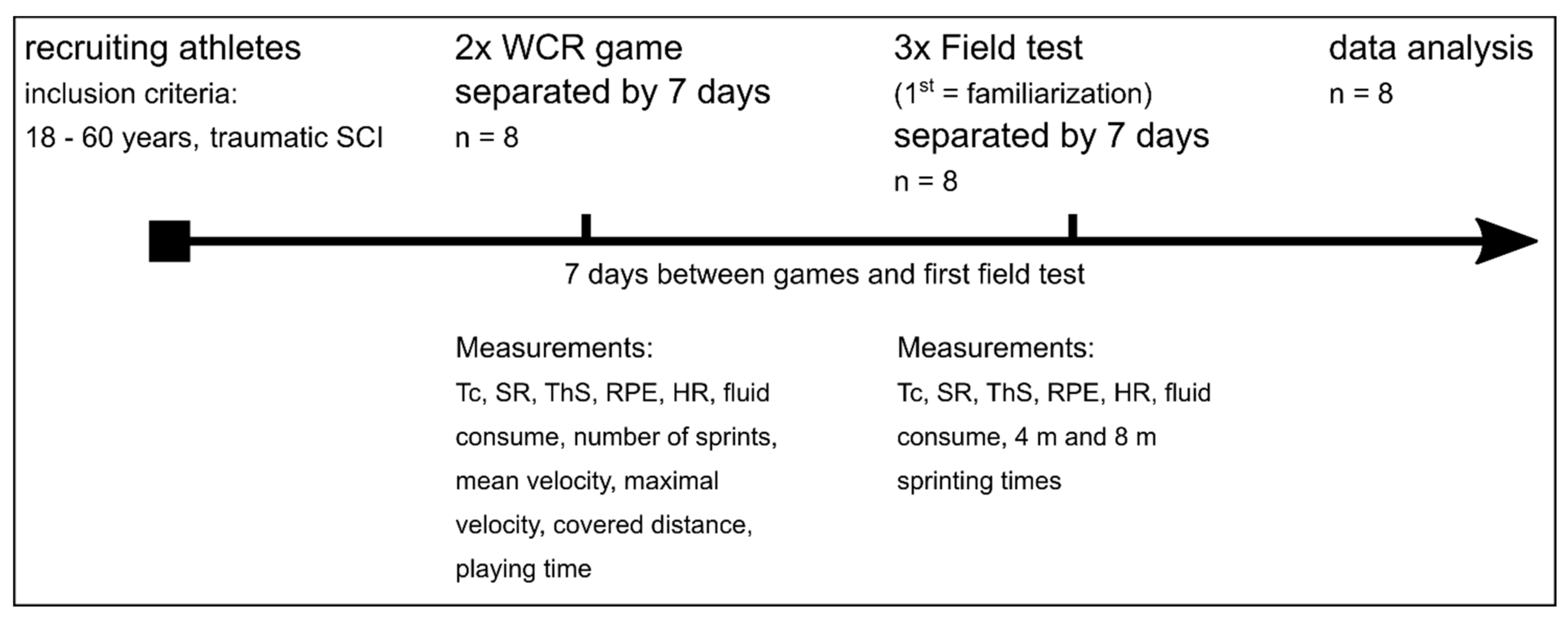
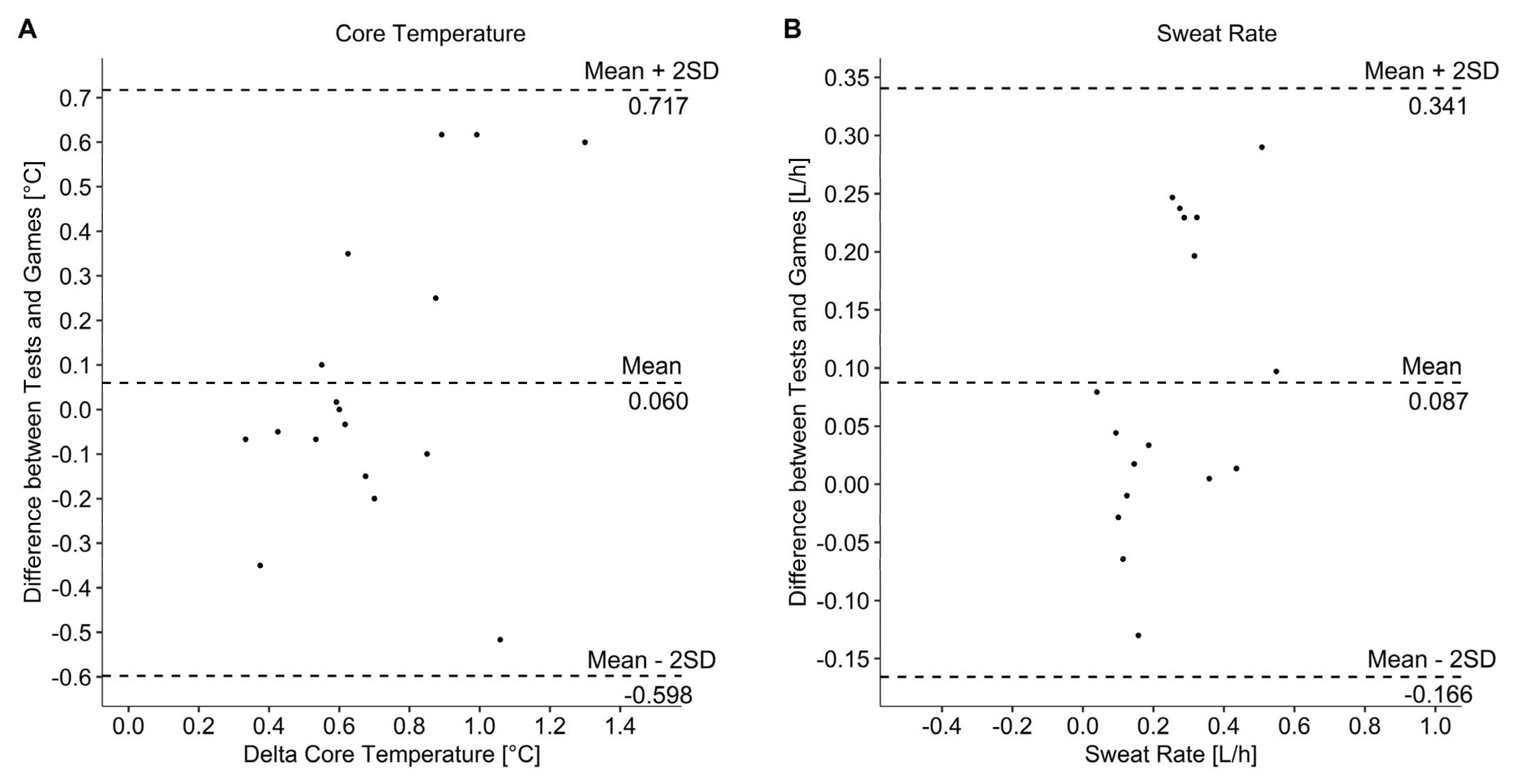
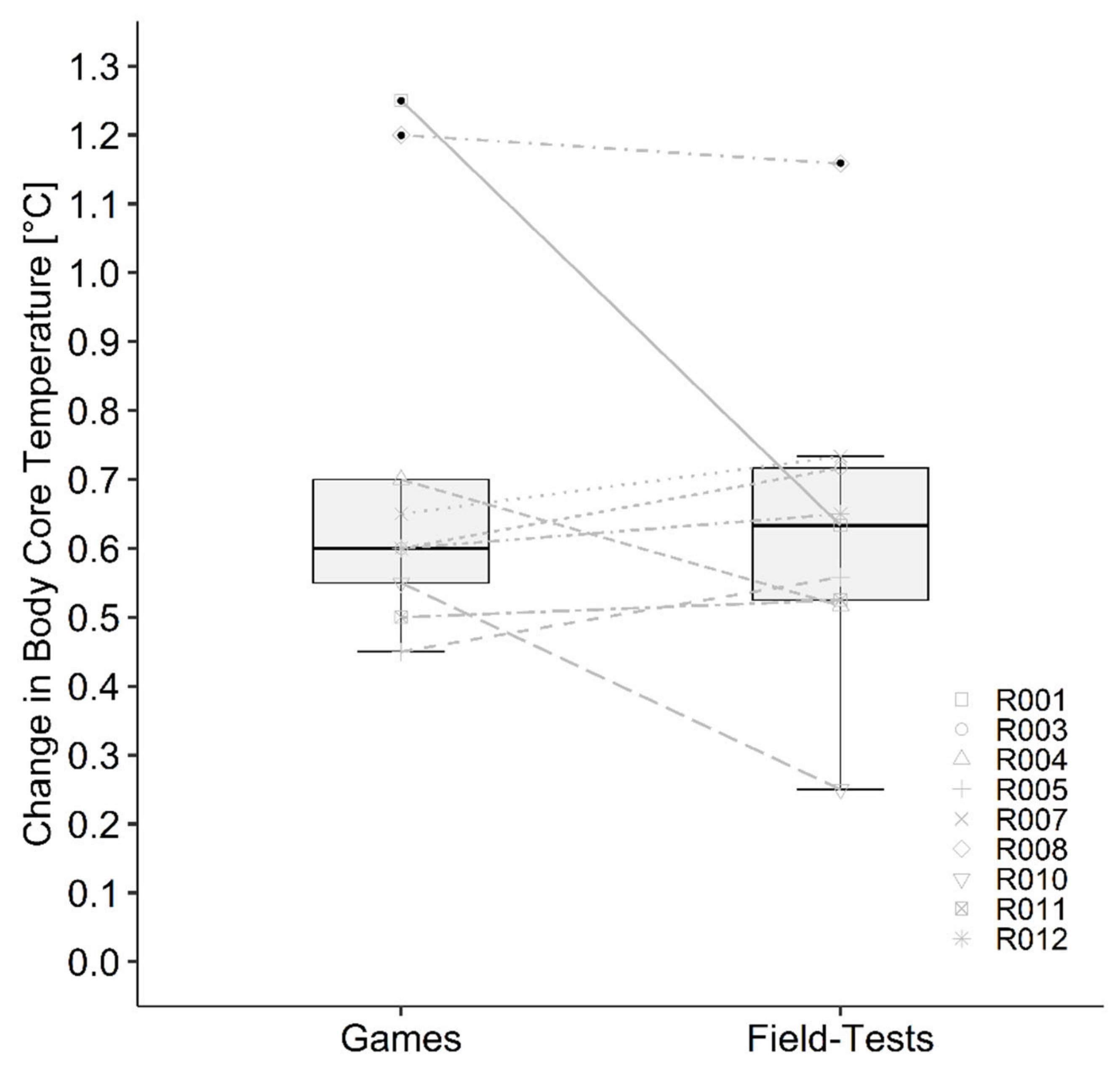
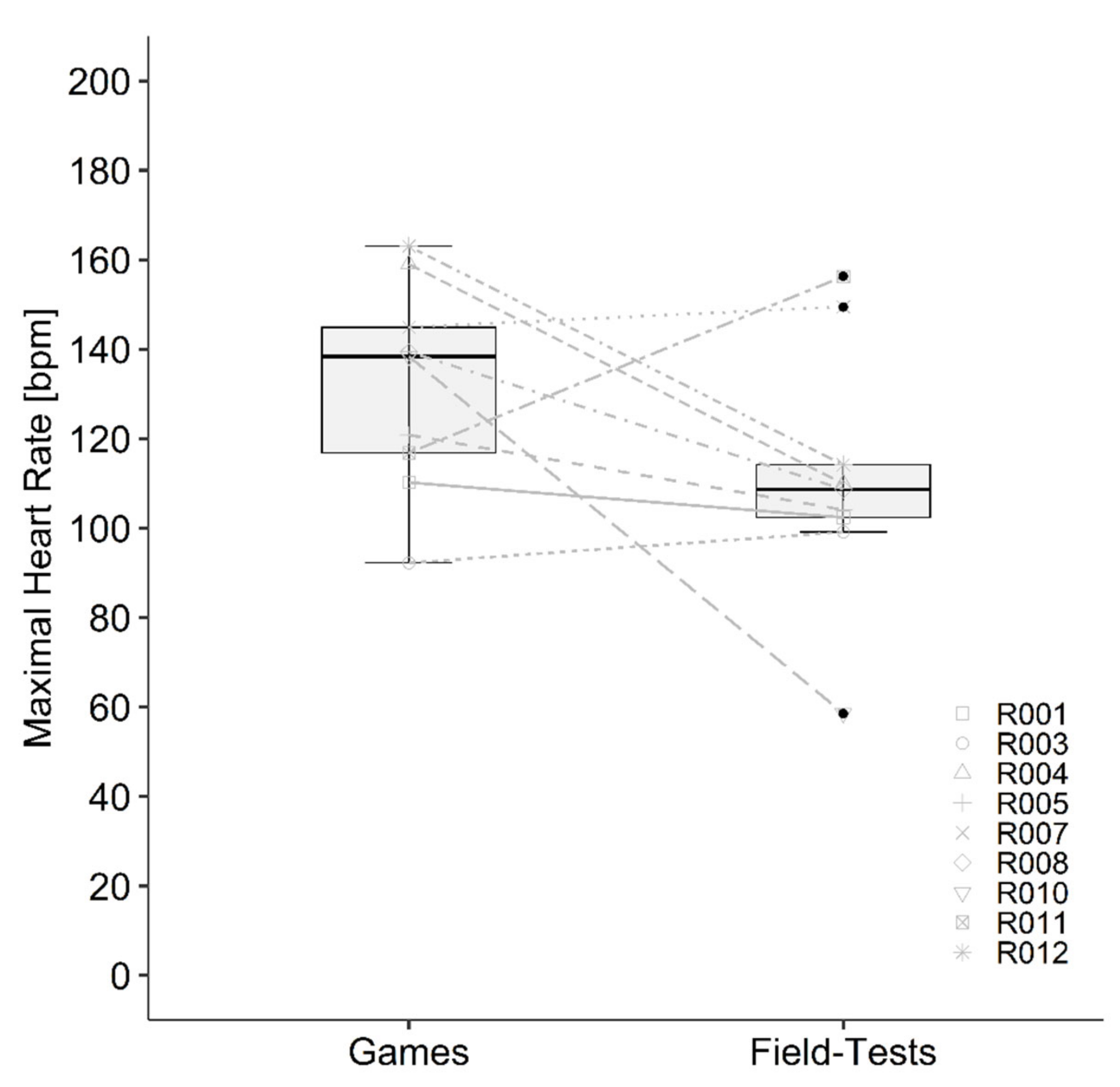
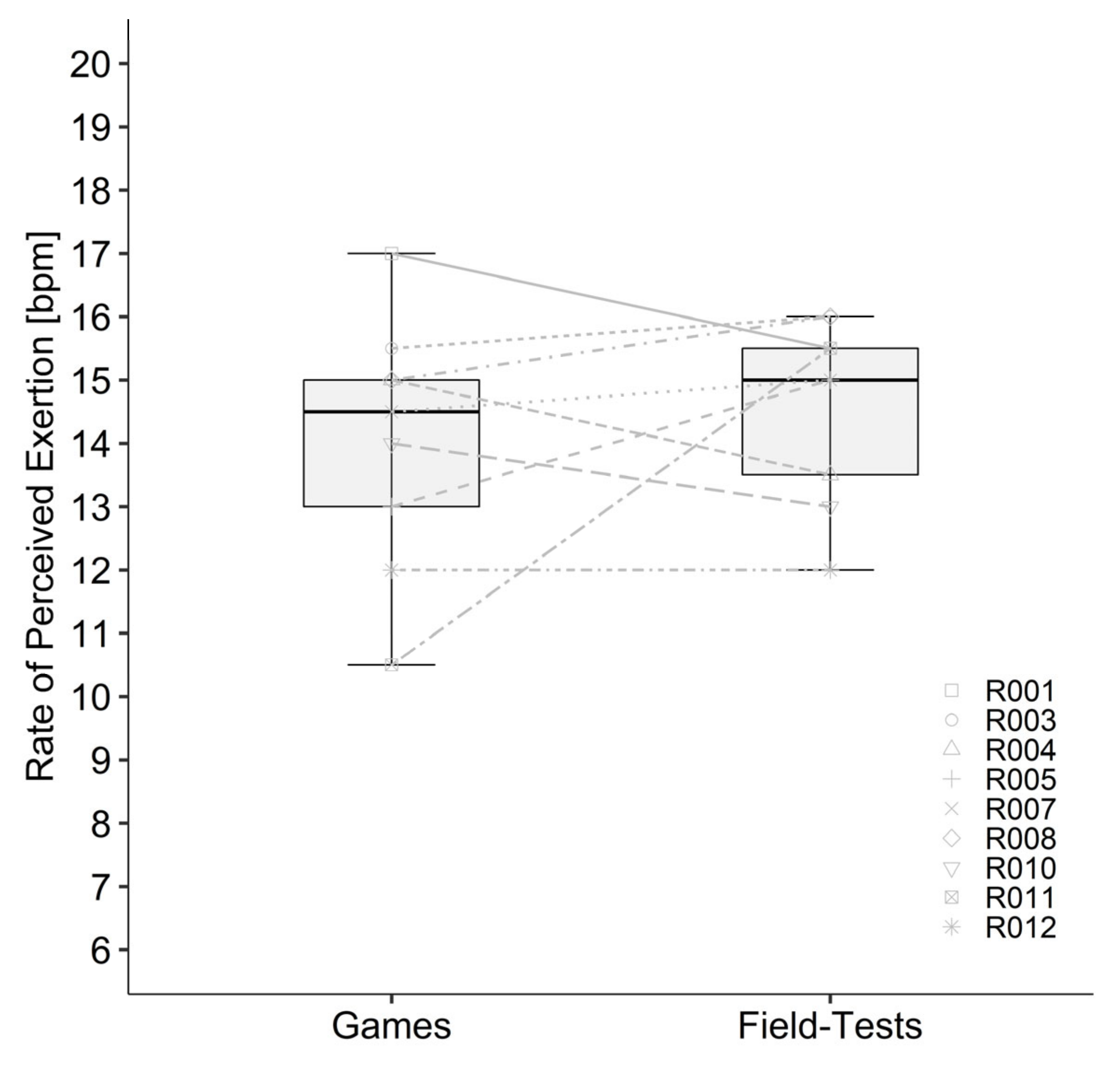
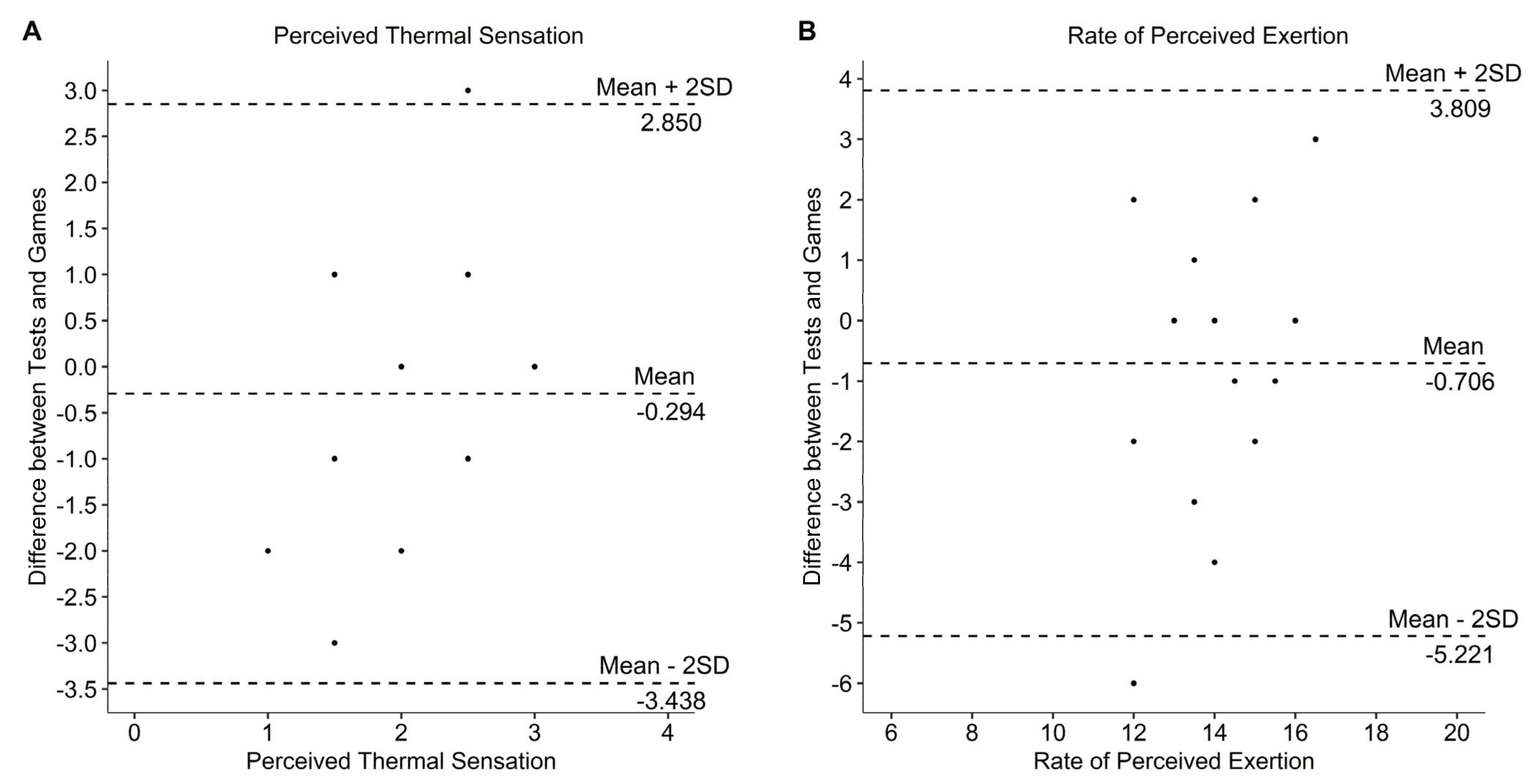
| ID | Age [Years] | Body Mass [kg] | Lesion Level | AIS | Classification |
|---|---|---|---|---|---|
| 1 | 36.2 | 91.9 | C6 | A | 0.5 |
| 2 | 49.0 | 78.0 | C5 | A | 0.5 |
| 3 | 37.9 | 92.6 | C5 | C | 1.5 |
| 4 | 28.7 | 63.7 | C5 | C | 0.5 |
| 5 | 42.6 | 67.0 | C6 | B | 1.5 |
| 6 | 45.4 | 64.6 | C7 | A | 2 |
| 7 | 42.2 | 77.3 | C6 | D | 2 |
| 8 | 37.3 | 89.8 | C8 | D | 3 |
| 9 | 25.3 | 73.6 | C7 | D | 2.5 |
| 10 | 32.2 | 68.0 | C7 | D | 2 |
| Median, IQR | 37.6, 6.3 | 75.5, 23.9 | - | - |
| Test 1 | Test 2 | Test Combined | Game 1 | Game 2 | Games Combined | Correlation between Tests and Games | ||||||||
|---|---|---|---|---|---|---|---|---|---|---|---|---|---|---|
| Measured Parameter | MED | IQR | MED | IQR | MED | IQR | MED | IQR | MED | IQR | MED | IQR | r | p-Value |
| Total distance [m] | 2048 | - | 2048 | - | 2048 | - | 2693 | 2331 | 2283 | 1874 | 2348 | 2186 | - | - |
| rel. distance [m/min] | 64 | - | 64 | - | 64 | - | 60.4 | 3.1 | 52.0 | 2.9 | 58.2 | 8.2 | - | - |
| Vmean [m/s] | 1.08 | - | 1.08 | - | 1.08 | - | 1.01 | 0.06 | 0.90 | 0.04 | 1.03 | 1.75 | - | - |
| Number of sprints | 64 | - | 64 | - | 64 | - | 26 | 33 | 17 | 28 | 20 | 35 | - | - |
| rel. sprint [sprint/min] | 2 | - | 2 | - | 2 | - | 0.5 | 0.3 | 0.3 | 0.4 | 0.5 | 0.5 | - | - |
| Test 1 | Test 2 | Tests Combined | Game 1 | Game 2 | Games Combined | Correlation between Tests and Games | Game vs. Field Test | ||||||||
|---|---|---|---|---|---|---|---|---|---|---|---|---|---|---|---|
| Measured Parameter | MED | IQR | MED | IQR | MED | IQR | MED | IQR | MED | IQR | MED | IQR | r | p-Value | p-Value |
| Playing time [min] | 32 | - | 32 | - | 32 | - | 42.3 | 30.0 | 36.7 | 20.6 | 39.5 | 28.7 | - | - | - |
| HRmean [bpm] | 98.4 | 16.9 | 103.24 | 13.30 | 103 | 14 | 118 | 22 | 118 | 22 | 104 | 28 | 0.328 | 0.197 | 0.459 |
| HRmax [bpm] | 106 | 19 | 110 | 22 | 110 | 14 | 121 | 32 | 140 | 32 | 129 | 32 | 0.416 | 0.097 | 0.080 |
| RPE [Borg] | 15 | 2 | 16 | 1 | 15 | 2 | 15 | 1 | 15 | 1 | 14 | 2 | 0.100 | 0.400 | 0.286 |
| ThS | 2 | 0.3 | 2.5 | 1 | 2 | 1 | 2 | 1.8 | 0 | 1 | 2 | 2 | 0.353 | 0.408 | 0.372 |
| Tcmean [°C] | 37.3 | 0.3 | 37.4 | 0.4 | 37.4 | 0.4 | 37.9 | 0.6 | 37.9 | 0.54 | 37.9 | 0.6 | 0.232 | 0.367 | 0.005 † |
| Tcmax [°C] | 37.7 | 0.2 | 37.9 | 0.3 | 37.8 | 0.3 | 38.25 | 1.1 | 38.3 | 0.5 | 38.3 | 1.0 | 0.256 | 0.320 | 0.011 † |
| TcDelta [°C] | 0.6 | 0.4 | 0.7 | 0.2 | 0.6 | 0.2 | 0.65 | 0.35 | 0.6 | 0.3 | 0.6 | 0.3 | 0.611 | 0.009 * | 0.831 |
| Sweat rate [L/h] | 0.15 | 0.05 | 0.19 | 0.13 | 0.17 | 0.09 | 0.4 | 0.22 | 0.16 | 0.31 | 0.39 | 0.31 | 0.740 | <0.001 * | 0.015 † |
| Fluid consume [L] | 0 | 0 | 0 | 0 | 0 | 0 | 0.39 | 0.28 | 0.26 | 0.36 | 0.29 | 0.32 | 0.123 | 0.636 | <0.001 † |
| Weight loss [kg] | 0.12 | 0.04 | 0.18 | 0.13 | 0.14 | 0.14 | 0.57 | 0.33 | 0.23 | 0.41 | 0.53 | 0.56 | 0.732 | <0.001 * | <0.001 † |
Publisher’s Note: MDPI stays neutral with regard to jurisdictional claims in published maps and institutional affiliations. |
© 2022 by the authors. Licensee MDPI, Basel, Switzerland. This article is an open access article distributed under the terms and conditions of the Creative Commons Attribution (CC BY) license (https://creativecommons.org/licenses/by/4.0/).
Share and Cite
Grossmann, F.; Flueck, J.L.; Roelands, B.; Meeusen, R.; Perret, C. Validity of a Wheelchair Rugby Field Test to Simulate Physiological and Thermoregulatory Match Outcomes. Sports 2022, 10, 144. https://doi.org/10.3390/sports10100144
Grossmann F, Flueck JL, Roelands B, Meeusen R, Perret C. Validity of a Wheelchair Rugby Field Test to Simulate Physiological and Thermoregulatory Match Outcomes. Sports. 2022; 10(10):144. https://doi.org/10.3390/sports10100144
Chicago/Turabian StyleGrossmann, Fabian, Joelle Leonie Flueck, Bart Roelands, Romain Meeusen, and Claudio Perret. 2022. "Validity of a Wheelchair Rugby Field Test to Simulate Physiological and Thermoregulatory Match Outcomes" Sports 10, no. 10: 144. https://doi.org/10.3390/sports10100144
APA StyleGrossmann, F., Flueck, J. L., Roelands, B., Meeusen, R., & Perret, C. (2022). Validity of a Wheelchair Rugby Field Test to Simulate Physiological and Thermoregulatory Match Outcomes. Sports, 10(10), 144. https://doi.org/10.3390/sports10100144








